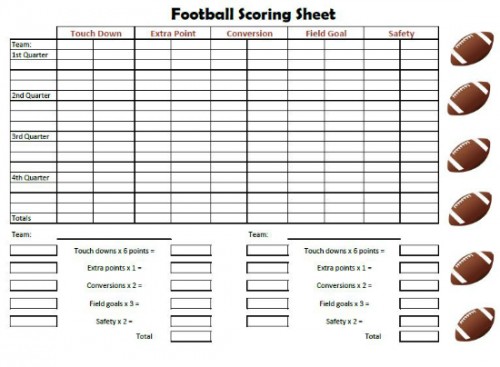By contributing writer Marci
Have you ever thought of football as a mathematical sport? Football is a game of numbers. Teams and fans keep track of yardage, tackles, and the score. It can be a great way to get your young football fanatics to become fans of math, too! Here are some ways to do football math with your kids.
Calculating the Score
Calcualting the score of football games can be a great lesson in addition and multiplication. You can give them different scoring scenarios for a game and let them calculate the final score.
First, you’ll need to make sure they know how football is scored.
touchdown = 6 points
extra point after a touchdown = 1 point
2 point conversion = 2 points
field goal = 3 points
safety = 2 points
Next, give them scenarios such as:
In the first quarter, the team scored a touchdown, an extra point and a field goal. How much did they score?
The team scored 4 touchdowns, 3 extra points, a 2 point conversion and a field goal. How much did they score?
You can make this as easy or as complicated as you want.
Football Scoring Sheet
You can also use this football scoring sheet to help them keep track of points as they watch a football game.
Calculating Running Distance at an Angle
In football, when a receiver gets the ball, he will run straight to the endzone. The job of the defending team is to stop him. Odds are that the defender will have run at an angle to try and catch the ball carrier. The defender needs to do some quick math.
The defender will instantly have to calculate the angle of pursuit in order to intercept the ball carrier. This also means the defender will have to run a longer distance than the ball carrier. How much farther?
Using the Pythagorean theorem, a² + b² = c², we can calculate the distance a defender needs to run to catch the ball carrier at a given point.
Let’s say the ball carrier is 30 yards from the end zone. Let’s say the ball carrier and defender start at the same point on the field. but 20 yards apart. If the ball carrier runs straight to the end zone, a right angle is created between the starting positions of the defender, the ball carrier and the end zone.
We can then use the pythagorean theorem to calculate the distance the defender has to run to intercept the ball carrier. If we say we want the defender to catch the ball carrier at the end zone, we know the ball carrier will have to run 30 yards. We also know that the ball carrier and receiver started 20 yards away from each other. Our calculation would look like this:
30² + 20² = C²
900 + 400 = C²
1300 = C²
take the square root of both sides: √1300 = √C²
C = 36.06 yards
To intercept the receiver at the end zone, the defensive player would have to run 36.06 yards. With the information you now have, you could even have more math fun and calculate the angle of pursuit.
On Your Own
What other football math calculations can you do?
- Keep track of the passing yards of the quarterback and then divide that number by the total passes to come up with a yard per pass average.
- Each time your favorite receiver carries the ball, keep track of his yardage and then calculate his average yards per play.
- Calculate the average points per quarter.
- Find out how many people your favorite football stadium holds. If each person bought a hot dog and soda for $9 (or whatever amount you want), how much money did the stadium make?
Think of more on your own! Have fun!
More Math Ideas from The Happy Housewife
- Real Life Math: Math in the Kitchen
- Preschool Math Activities
- Mammal Themed Math Worksheets (2nd – 4th grade)
- Fish Themed Math Worksheets (2nd – 4th grade)
- Circus Themed Math Worksheets (2nd – 4th grade)
- Free Math Printables (Elementary Math, Algebra, Geometry)








Nancysue says
Marci, I know this is an older post, but sooo glad I found it today 🙂 Clemson University’s first football game was this past Saturday, and your Football math work is perfect for our homeschooled son and dad bonding time! Hubby is excited! You never know when someone will use your “blast for the past” posts. Thank you for your hard work putting it together, and enjoy your Labor Day 2015!
Marci@TheHomeschoolScientist says
Thanks NancySue! I’m so glad you found this post. You’ve got to love math that is fun….and bonding 🙂